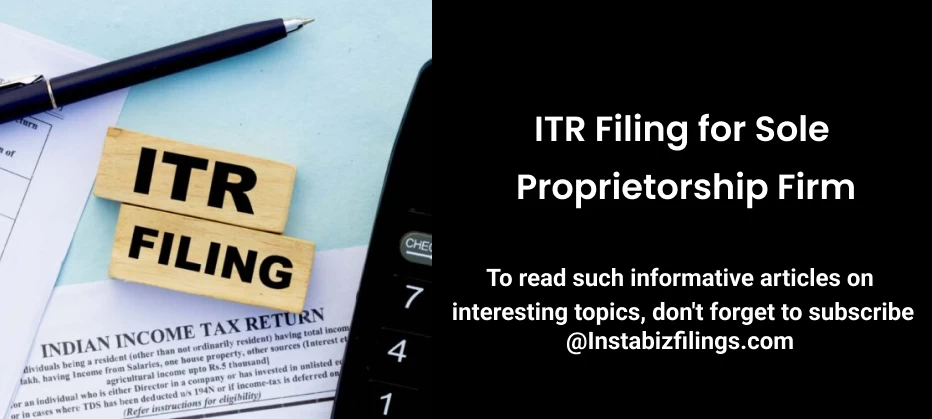
ITR Filing for Sole Proprietorship Firm
March 18, 2025 by Team Instabizfilings
What is a Sole Proprietorship Firm?
A Sole Proprietorship is a business structure in which the business and the owner are considered a single entity. The owner has complete control over the operations of the business and is personally liable for its debts. Sole Proprietorships are the simplest form of business organization and are commonly used by small business owners, freelancers, and consultants.
Why is ITR Filing Important for Sole Proprietors?
All individuals together with businesses must file Income Tax Returns whenever their yearly earnings surpass the specified exemption level. Every individual must meet this legal requirement since non-compliance results in penalties. The legal requirement to file ITR comes into effect for sole proprietors because of the following reasons:
-
Tax Compliance through Income Tax Act compliance secures the business from fines and legal consequences.
-
Filing income tax returns enables businesses to obtain financial support from banks and financial institutions which will lead to business growth.
-
Business owners need to file their tax returns because this practice lets them document their expenses and income properly for potential audit situations as well as business reviews.
What are the Types of ITR Forms for Sole Proprietorship Firms?
Sole Proprietors need to file the appropriate ITR form based on their income source. The most common forms used by Sole Proprietors are:
-
ITR-3: This form is used by individuals and Hindu Undivided Families (HUFs) who have income from business or profession, and also income from other sources like salary, house property, or capital gains.
-
ITR-4 (Sugam): This form is specifically for individuals, HUFs, and firms (other than LLP) who have a presumptive income under sections 44AD, 44ADA, or 44AE.
a. ITR-3:
-
For proprietors having income from business or profession (books of accounts are maintained).
-
Used when the income is above the threshold limits for presumptive taxation.
b. ITR-4 (Sugam):
-
For small businesses with income under presumptive taxation schemes like:
- Section 44AD: For businesses with a turnover of up to ₹2 crore (presumptive income is 8% of total turnover).
- Section 44ADA: For professionals with gross receipts up to ₹50 lakh (presumptive income is 50% of gross receipts).
- Section 44AE: For owners of goods vehicles with a limited number of vehicles.
Eligibility Criteria for Filing ITR-4 (Sugam)
If a sole proprietor qualifies under the presumptive taxation scheme, they are required to file ITR-4 (Sugam), provided they meet the following criteria:
-
Income from business or profession.
-
Business turnover or gross receipts should be less than ₹2 crore (for non-professionals).
-
Gross receipts should be less than ₹50 lakh (for professionals under Section 44ADA).
-
The individual does not have any income under capital gains, or income from other sources.
Required Documents for Filing ITR for Sole Proprietorship
Before you begin filing your tax returns, it’s essential to gather the necessary documents:
-
PAN card of the proprietor and the firm.
-
Profit & Loss Account and Balance Sheet for the relevant financial year.
-
Bank Statements for the entire financial year.
-
Documentation for turnover and business income.
-
If the business is registered under GST, then the GST returns filed during the year.
-
Tax Deducted at Source (TDS) certificates (if applicable).
-
Cash book, ledger, journal, etc. (if applicable).
Steps to File ITR for a Sole Proprietorship
Here is a step-by-step guide to filing ITR for a sole proprietorship:
- Step 1: Determine the Applicable ITR Form
- First, determine whether you need to file ITR-3 or ITR-4 based on your income.
- Step 2: Log in to the Income Tax E-filing Portal
-
Visit the Income Tax Department's e-filing website: www.incometaxindiaefiling.gov.in.
-
Register/login using your PAN number, mobile number, and email.
- Step 3: Fill in the Details of the Form
-
Personal Details: Include basic information like name, address, and date of birth.
-
Income Details: Mention your total income from business, profession, salary (if any), and any other sources.
- For ITR-4, report your income as per the presumptive tax scheme (Section 44AD, 44ADA, or 44AE).
- If you are using ITR-3, provide the business profits and income as per the books of accounts.
3. Deductions: Claim any deductions available under sections like 80C (LIC, PPF, etc.), 80D (health insurance), etc.
- Step 4: Calculate Tax Payable
- The portal automatically calculates your tax based on the details entered. You can also check for rebates and credits under applicable sections, like Section 87A.
- Step 5: Verify and Submit the Form
- After filling the details, verify the entries. Then, submit the form electronically.
- Step 6: Pay Taxes (If Applicable)
- If taxes are due, make the payment through the e-payment facility available on the portal. Ensure you use the correct challan for income tax payments.
- Step 7: Submit and E-Verify
- Once the payment is done, submit the return and choose an e-verification method. You can e-verify using Aadhaar OTP, net banking, or by sending a signed copy of ITR-V to the Income Tax Department.
Common Mistakes to Avoid While Filing ITR
-
Incorrect Form Selection: Choosing the wrong form (ITR-3 vs ITR-4) can lead to complications and rejection.
-
Missing Income Details: Ensure all income sources (business, capital gains, etc.) are reported.
-
Errors in Financial Statements: Ensure all financial data such as turnover, profit, and loss is accurately mentioned.
-
Non-disclosure of GST/Tax Liabilities: If GST is applicable, ensure it is accurately mentioned in the return.
Due Date for Filing ITR
-
For individuals and non-audited businesses, the due date for filing ITR is 31st July of the assessment year.
-
For audited businesses, the due date is usually 30th September.
Penalty for Non-filing
You could get fined up to ₹10,000 under Section 234F of the Income Tax Act because of late ITR filing according to your actual submission timeline after the deadline. The late payment of taxes entitles you to interest rates defined in Sections 234A, 234B and 234C.
Conclusion
All sole proprietors must file their ITR because it helps maintain business compliance and penalties avoidance while allowing for business efficiency. A proper system of execution combined with detailed documentation makes the process easier to handle. Working with a certified tax professional is crucial in all complicated cases or whenever you question your eligibility for tax schemes.
The practice of regular return filing works to build a strong business reputation which enables easier business expansion.
Disclaimer
The information provided in this blog is purely for general informational purposes only. While every effort has been made to ensure the accuracy, reliability and completeness of the content presented, we make no representations or warranties of any kind, express or implied, for the same.
We expressly disclaim any and all liability for any loss, damage or injury arising from or in connection with the use of or reliance on this information. This includes, but is not limited to, any direct, indirect, incidental, consequential or punitive damage.
Further, we reserve the right to make changes to the content at any time without prior notice. For specific advice tailored to your situation, we request you to get in touch with us.


